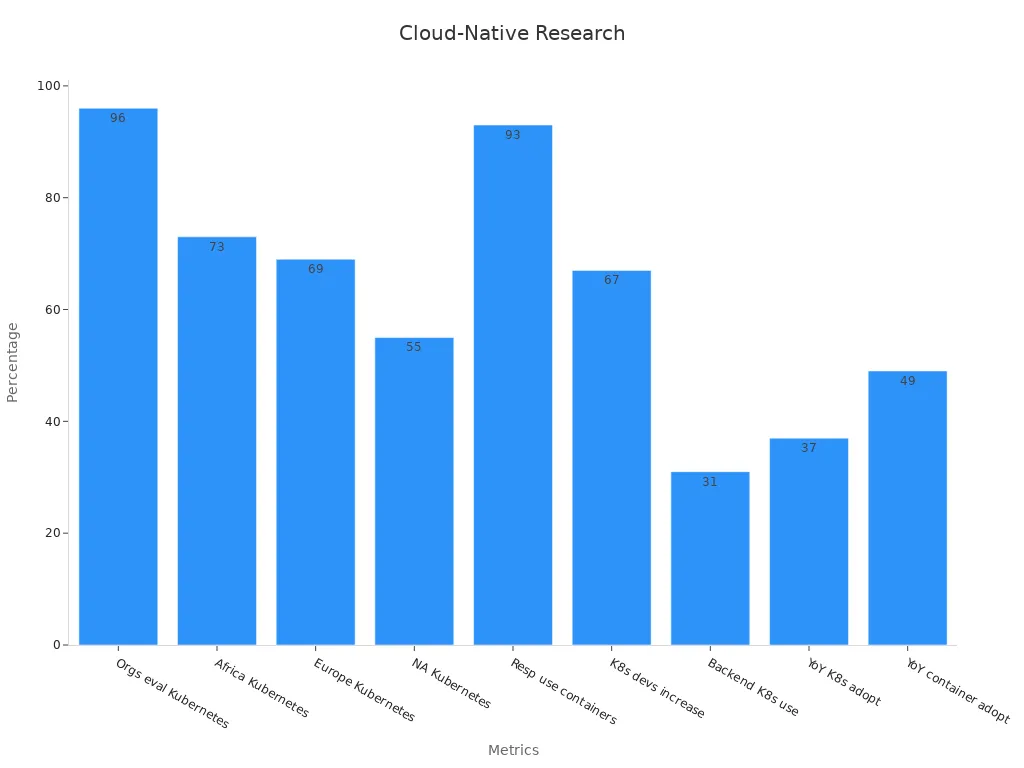Cloud-native computing represents a modern approach to designing and deploying applications that fully utilize cloud environments. By prioritizing scalability, resilience, and automation, it enables organizations to adapt swiftly to changing demands. This computing paradigm plays a critical role in digital transformation, as 90% of companies now leverage platforms like AWS, Azure, and Google Cloud for development. With public cloud services generating $191 billion in revenue from 2021 to 2022, the shift to cloud-native practices demonstrates its importance in modernizing software development and fostering innovation across industries.
Key Takeaways
Cloud-native computing helps systems grow and stay strong. It lets businesses adjust fast to new needs.
With microservices and containers, cloud-native apps use resources better. They also make building apps easier.
Using cloud-native methods can save money with pay-as-you-go plans. It also lowers running costs.
Cloud-native tools help developers create new things faster. This speeds up launches and boosts work output.
Fields like healthcare and online shopping gain a lot from cloud-native tools. They work better and make customers happier.
Understanding Cloud-Native Computing

Definition and Characteristics of Cloud-Native
Cloud-native computing refers to a modern approach to building and running applications that fully exploit the advantages of cloud computing. These applications are designed specifically for cloud environments, enabling businesses to achieve greater agility, scalability, and resilience. Unlike traditional monolithic applications, cloud-native systems adopt a microservices architecture, where each service operates independently and can be deployed or scaled without affecting others.
Key characteristics of cloud-native applications include:
Resilience: They maintain functionality even when individual components fail.
Portability: They can run seamlessly across different cloud platforms.
Scalability: They dynamically allocate resources based on demand.
Manageability: They simplify operations through automation and observability.
"Cloud-native computing uses an open-source software stack to deploy applications as microservices, packaging each part into its own container, and dynamically orchestrating those containers to optimize resource utilization."
This approach also shortens application lifecycles, allowing businesses to respond quickly to market changes and customer needs.
How Cloud-Native Leverages Cloud Environments
Cloud-native strategies maximize the potential of cloud environments by utilizing their distributed nature and on-demand resources. These applications are built to take advantage of cloud-specific features, such as elastic scalability and pay-as-you-go pricing models. By breaking applications into smaller, loosely coupled services, cloud-native computing ensures flexibility and efficient resource utilization.
Key ways cloud-native leverages cloud environments include:
Enhanced asset utilization: Lightweight components, such as containers, allow rapid scaling and resource optimization.
Streamlined development: Developers gain access to cloud services, APIs, and tools, enabling them to focus on coding rather than infrastructure management.
Consistency across environments: Containerization technologies like Docker and Kubernetes ensure that applications behave the same way in development, testing, and production.
Cost efficiency: Pricing models based on actual usage reduce operational expenses.
For example, automated CI/CD pipelines in cloud-native environments enable frequent updates to runtime versions, ensuring applications remain secure and up-to-date. This approach not only improves performance but also minimizes risks associated with outdated software.
Examples of Cloud-Native Technologies and Tools
Several technologies and tools form the backbone of cloud-native computing, each playing a critical role in its ecosystem. These include:
Containers: Tools like Docker package applications and their dependencies, ensuring portability and consistency.
Container orchestration platforms: Kubernetes automates the deployment, scaling, and management of containerized applications.
Serverless computing: Platforms like AWS Lambda allow developers to run code without managing servers, reducing operational overhead.
Microservices frameworks: Tools such as Spring Boot and Istio facilitate the development and management of microservices.
CI/CD pipelines: Jenkins and GitLab CI/CD streamline the software delivery process, enabling faster and more reliable deployments.
| Key Findings | Statistics |
| Containers usage | 44% of respondents use containers for nearly all applications. |
| Kubernetes adoption | 66% of providers and consumers used Kubernetes in production in 2023. |
| Serverless architecture | 37% of organizations have experience deploying applications with WebAssembly. |
These tools and technologies empower organizations to build applications that are not only scalable and resilient but also optimized for the cloud's distributed nature. By adopting these solutions, businesses can enhance their software delivery pipelines and maintain a competitive edge in the digital landscape.
Why Cloud-Native Computing Matters
Benefits for Businesses, Including Scalability and Cost-Efficiency
Cloud-native computing offers transformative benefits for businesses, particularly in scalability and cost-efficiency. By leveraging cloud-native technologies, organizations can dynamically scale their applications to meet fluctuating demands. This ensures optimal resource utilization and prevents over-provisioning. Additionally, the pay-as-you-go pricing model of cloud platforms reduces operational expenses, allowing businesses to allocate budgets more effectively.
Key advantages for businesses include:
Resource optimization: Automation and scalability reduce waste and improve efficiency.
Cost savings: Containerization and microservices enable efficient deployment and agile iteration, supporting diverse computing scenarios like quantitative model training.
Operational excellence: Cloud-native systems streamline workflows, enhancing productivity and reducing downtime.
"Resource utilization, scalability, and automation are key parameters that influence cost savings and operational excellence."
These benefits empower businesses to remain competitive in a fast-paced digital landscape while maintaining financial sustainability.
Advantages for Developers, Such as Faster Deployment and Innovation
Cloud-native computing significantly enhances the developer experience by enabling faster deployment and fostering innovation. Developers can utilize tools like CI/CD pipelines and GitOps to automate repetitive tasks, allowing them to focus on creating innovative solutions. This approach reduces lead times for changes and accelerates the delivery of new features.
| Statistic Description | Value |
| Lead times for changes with DevOps practices | 200 times faster |
| Increase in deployment speed due to collaboration | 35% increase |
| Increase in developer productivity with GitOps | 38% increase |
These statistics highlight the tangible improvements cloud-native systems bring to software development. By adopting these practices, developers can experiment with new ideas, iterate quickly, and deliver high-quality applications that meet user expectations.
Role in Driving Digital Transformation and Competitive Advantage
Cloud-native computing plays a pivotal role in driving digital transformation and securing a competitive edge for organizations. Its flexibility and speed enable businesses to adapt to market changes and customer demands more effectively. The global cloud-native applications market reflects this trend, with an expected growth rate of 23.7% CAGR from 2023 to 2028. By 2028, the market size is projected to reach USD 17.0 billion, up from USD 5.9 billion in 2023.
Key factors contributing to this growth include:
Flexibility: Cloud-native applications can be updated and scaled rapidly, ensuring they remain relevant in dynamic markets.
Speed: Faster development cycles allow businesses to launch products and services ahead of competitors.
Organizations that embrace cloud-native computing position themselves as leaders in their industries. They gain the ability to innovate continuously, respond to customer needs promptly, and maintain a strong market presence.
Core Principles of Cloud-Native Architecture
Microservices and Their Role in Cloud-Native
Microservices form the backbone of cloud-native architecture. They break down applications into smaller, independent services, each responsible for a specific function. This modular approach enhances scalability, resilience, and agility. Each microservice operates independently, allowing teams to deploy updates without disrupting the entire system.
Key principles of microservices include:
Single code base: Each microservice maintains its own repository, ensuring clear separation of concerns.
Isolated dependencies: Dependencies are packaged within the service, reducing conflicts.
Externalized configurations: Configuration data is managed separately, enabling flexibility across environments.
Concurrency and disposability: Services scale horizontally and can be replaced quickly if needed.
| Metric | Impact |
| Deployment Frequency | 20-30% increase |
| Lead Time for Changes | 50% reduction |
| Service Outages | 50% reduction |
| Response Times Improvement | 40% improvement |
| Throughput Increase | 40% increase |
| Latency Decrease | 25% decrease |
These metrics highlight the efficiency and reliability microservices bring to cloud-native systems, enabling faster innovation and improved user experiences.
Containers and Container Orchestration
Containers and their orchestration are essential for running cloud-native applications. Containers package applications and their dependencies, ensuring consistency across environments. Tools like Docker simplify container creation, while orchestration platforms such as Kubernetes automate deployment, scaling, and management.
Benefits of container orchestration include:
Improved security: Consistent policies reduce vulnerabilities.
Increased availability: Failed containers restart automatically, ensuring uptime.
Optimized resource usage: Automation reduces repetitive tasks, freeing teams for strategic work.
Enhanced resilience: Systems scale and recover dynamically.
For example, Kubernetes can detect and resolve issues faster than manual intervention, maintaining application performance and quality. This automation ensures businesses can meet user demands efficiently.
Automation, DevOps, and Infrastructure as Code
Automation and DevOps practices are integral to cloud-native computing. Automation minimizes manual intervention, reducing errors and improving efficiency. DevOps fosters collaboration between development and operations teams, accelerating delivery cycles. Infrastructure as Code (IaC) tools like Terraform enable teams to manage infrastructure through scripts, ensuring consistency and speed.
Key benefits of automation and IaC include:
Operational excellence: Automated environments streamline workflows.
Reliability: Automated processes enhance system resilience.
Cost management: Incremental value is generated early, optimizing budgets.
By integrating these practices, organizations can build robust, scalable systems that adapt to evolving demands. Automation and IaC empower teams to focus on innovation rather than routine tasks, driving long-term success.
Cloud-Native vs. Traditional Approaches
Differences from Monolithic Architecture
Monolithic architecture and cloud-native strategies differ significantly in their design and operational approaches. Monolithic systems bundle all components into a single application, making them rigid and challenging to scale. In contrast, cloud-native systems adopt a modular approach, leveraging microservices to ensure flexibility and scalability.
| Feature | Monolithic Architecture | Cloud-native Technology |
| Scalability | Handles moderate data, struggles with large volumes | Automatically scales resources for large operations |
| Flexibility | Tightly coupled components, less adaptable | Loosely coupled, quick adaptation and integration |
| Deployment & Updates | Requires thorough testing and redeployment | Proactive adoption of new technologies, continuous updates |
| Processing Power & Performance | Limited processing power, requires upgrades | Dynamically optimizes resources and processing power |
Monolithic systems often require significant downtime for updates, while cloud-native systems enable continuous delivery. This difference allows businesses to innovate faster and respond to market demands more effectively.
Comparison with Lift-and-Shift Cloud Migration
Lift-and-shift migration involves moving existing applications to the cloud without redesigning them. While this approach offers a quick transition, it fails to leverage the full potential of cloud environments. Cloud-native computing, on the other hand, optimizes applications for the cloud, ensuring better performance and cost efficiency.
| Aspect | Cloud-Native Approach | Traditional Approach |
| Development Time | Faster, with a focus on flexibility and iterative releases | Slower, often released as a single large package |
| OS Dependency | Abstracts OS dependencies for easier migration | Dependent on OS, complicating migration and scalability |
| Collaboration | Fosters teamwork through DevOps model | Works in silos, limiting communication |
| Release Pace | Quick updates through microservices | Slower, with longer cycles for updates |
| Cost | Pay-per-use model, cost-effective | Fixed costs for infrastructure, regardless of usage |
Lift-and-shift strategies often retain the limitations of traditional systems, such as OS dependency and slower release cycles. Cloud-native systems overcome these challenges by embracing automation, microservices, and containerization.
Unique Value and Advantages of Cloud-Native Computing
Cloud-native computing offers unique advantages that set it apart from traditional approaches. Its modular design and automation capabilities enable organizations to innovate rapidly while maintaining operational efficiency. Kubernetes, a key cloud-native technology, has seen widespread adoption, with 96% of organizations either using or evaluating it.

Key metrics highlight the growing adoption of cloud-native technologies:
93% of respondents use or plan to use containers.
Kubernetes adoption has increased by 37% year-over-year.
Backend developers using Kubernetes have grown to 31%.
These statistics underscore the transformative potential of cloud-native computing. By adopting this approach, businesses can achieve scalability, cost efficiency, and a competitive edge in the digital landscape.
Real-World Applications of Cloud-Native Computing

Use Cases in Industries Like E-Commerce, Healthcare, and Finance
Cloud-native computing has revolutionized industries by enabling scalable, efficient, and innovative solutions. In healthcare, telemedicine platforms leverage cloud-native technologies to expand access to remote care, reducing hospital readmissions and improving patient convenience. AI-powered diagnostics enhance accuracy, cutting diagnostic errors by up to 40%. Additionally, electronic health records (EHRs) streamline data sharing among providers, improving care coordination and reducing redundant tests.
In e-commerce, cloud-native systems support dynamic scaling during peak shopping seasons. Retailers use machine learning to analyze customer behavior, enabling personalized recommendations and targeted marketing. Finance companies benefit from real-time fraud detection and risk analysis powered by cloud-native platforms. These systems process vast amounts of transactional data, ensuring security and compliance while enhancing customer trust.
Success Stories of Businesses Adopting Cloud-Native Practices
Several organizations have achieved remarkable success by adopting cloud-native practices. Giftagram transitioned from a B2C gifting startup to a B2B enterprise by implementing scalable cloud infrastructure. This shift enabled them to support major clients like Spotify and Meta, enhancing operational efficiency and analytics capabilities.
The Boston Celtics also embraced cloud-native solutions by migrating from Microsoft SQL Server to Amazon Aurora. This move reduced licensing costs and improved database performance. By integrating Amazon ElastiCache, they achieved faster data retrieval, reducing database load and enhancing overall system performance. These examples highlight how cloud-native computing drives innovation and operational excellence across diverse sectors.
Emerging Trends and Future Potential of Cloud-Native
The future of cloud-native computing is shaped by emerging trends such as multi-cloud strategies, serverless computing, and the integration of AI and machine learning. Organizations increasingly adopt multi-cloud approaches to optimize performance and reduce vendor dependency. Serverless computing eliminates the need for infrastructure management, allowing developers to focus on innovation.
The growing emphasis on data center modernization and cloud security skills reflects the evolving demands of the industry. As businesses transition from on-premises infrastructure to cloud and edge computing, the need for unified environments and advanced technical expertise will rise. These trends underscore the expanding role of cloud-native computing in driving digital transformation and innovation.
Cloud-native computing has redefined how organizations build and deploy applications, leveraging the cloud's scalability, resilience, and automation. Its significance lies in enabling businesses to modernize operations, enhance customer engagement, and drive innovation. Developers benefit from faster deployment cycles and tools that simplify complex workflows.
Key advantages include:
Improved understanding of customer preferences through AI and big data integration.
The ability to analyze vast datasets generated by mobile devices and social media.
Adopting cloud-native practices positions organizations for long-term success, empowering them to adapt to evolving market demands and maintain a competitive edge.
FAQ
What is the difference between cloud-native and traditional applications?
Cloud-native applications are designed for scalability, resilience, and automation in cloud environments. Traditional applications often rely on monolithic architectures, making them less flexible and harder to scale. Cloud-native systems use microservices, containers, and orchestration tools to optimize performance and resource utilization.
How does cloud-native computing improve scalability?
Cloud-native computing uses microservices and container orchestration to dynamically allocate resources based on demand. This ensures applications can handle traffic spikes without over-provisioning. Kubernetes, for example, automates scaling, allowing businesses to maintain performance during peak usage.
Are cloud-native systems secure?
Yes, cloud-native systems enhance security through container isolation, automated updates, and consistent policies. Tools like Kubernetes enforce security best practices, while DevOps pipelines ensure vulnerabilities are addressed promptly. Regular monitoring and compliance checks further strengthen security.
What industries benefit most from cloud-native computing?
Industries like e-commerce, healthcare, and finance gain significant advantages. E-commerce platforms scale during peak seasons, healthcare systems enable telemedicine, and financial institutions use real-time fraud detection. Cloud-native solutions support innovation and efficiency across diverse sectors.
Can small businesses adopt cloud-native practices?
Absolutely. Cloud-native computing offers cost-effective solutions for small businesses. Pay-as-you-go pricing models and serverless computing reduce infrastructure costs. Tools like Docker and Kubernetes simplify deployment, enabling small teams to build scalable, resilient applications without extensive resources.






